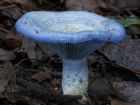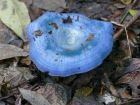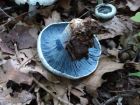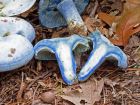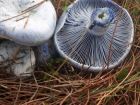Cap firm, convex with a depressed disc and inrolled margin at first, becoming shallowly funnel-shaped. The surface is smooth, pale to light- or purplish-blue when fresh, later greyish or silvery. Gills attached to the stem or beginning to run down it and crowded close together. Their colour is an indigo blue, becoming paler with age or staining green with damage. Stem cylindric or tapering to base, and hard. The surface is sticky and sometimes spotted. Flesh whitish, turning indigo blue when cut; staining slowly greenish. Spore print pale yellowish.
Microscopic Features: The spores are broadly ellipsoid to subglobose, measuring 7-10 x 5.5-7.5 µ. They have an ornamentation of amyloid warts and connecting lines, reaching a height of approximately 0.5 µ. Occasionally, these warts and lines form partial reticula.
Lactarius indigo on the MushroomExpert.Com web site.
The second photo is by Bernard Dupont and licensed under the Creative Commons Attribution-Share Alike 2.0 Generic license.
Many mushrooms are poisonous, and some can be lethally toxic. Distinguishing between edible and poisonous mushrooms can be very challenging. Therefore, we strongly advise against consuming wild mushrooms. This website does not contain any information about the edibility or toxicity of mushrooms.
Although efforts have been made to ensure accuracy on this website, the information may contain errors and omissions. Therefore, all content provided is for educational and informational purposes only and should not be relied upon or used as a basis for consuming any plants or mushrooms.
External links are provided for reference only. We do not endorse or take responsibility for the content, advice, or products found on these sites or in any advertisements shown on this website.
